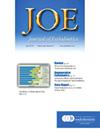Integration of an Ultrasonic Device into Dynamic Navigation System for a Fully Guided Dynamic Endodontic Microsurgery Workflow: An In Vitro Study
IF 3.5
2区 医学
Q1 DENTISTRY, ORAL SURGERY & MEDICINE
引用次数: 0
Abstract
Introduction
This study investigates the feasibility of integrating an ultrasonic (US) device into a dynamic navigation system (DNS) for a fully guided dynamic endodontic microsurgery (EMS) workflow. It compares the accuracy and efficiency of fully guided dynamic US + DNS to US + freehand (FH) workflow.
Methods
Thirty-eight mandibular molars were divided into 2 groups: US + DNS (n = 19) and US + FH (n = 19). Cone-beam computed tomography scans were taken pre- and postoperatively. Bone window cut (BWC), root-end resection (RER), root-end cavity preparation (RECP), and root-end filling (REF) were planned in the X-guide. BWC, RER, RECP, and REF were all conducted under dynamic navigation. Three-dimensional deviations were measured for BWC. Resected root length and resection angle were calculated for the RER. Frequency long-axis deviation was recorded for RECP, and REF depth was measured. Total operating time was recorded.
Results
The fully guided US + DNS was more accurate than US + FH, showing lesser 3-dimensional deviations for BWC (P < .0001). The resected root length was ∼3 mm (P > .05). The RER angle was lower in US + DNS (P < .0001). RECP long-axis deviations were lesser in US + DNS (P < .05). The REF depth average was 3 mm for US + DNS and 2.78 mm for US + FH (P < .05). Both EMS workflows were time efficient for EMS, with US + FH taking less time (P < .05).
Conclusions
Within the limitations of this study, it is feasible to integrate US into a DNS for a fully guided dynamic EMS workflow. Fully guided dynamic EMS workflow improved overall EMS accuracy.
将超声设备集成到动态导航系统中,实现全导向动态牙髓显微手术流程:一项体外研究。
本研究探讨了将超声设备(US)集成到动态导航系统(DNS)中的可行性,以实现全导向动态牙髓显微外科(EMS)工作流程。它比较了完全引导的动态US + DNS与US +徒手(FH)工作流程的准确性和效率。方法:38颗下颌磨牙分为US + DNS组(n=19)和US + FH组(n=19)。术前和术后分别行CBCT扫描。X-guide计划骨窗切开(BWC)、根端切除(RER)、根端空腔制备(RECP)和根端填充(REF)。BWC、RER、RECP和REF均在动态导航下进行。测量BWC的三维偏差。计算RER的切除根长度和切除角度。记录RECP的频率长轴偏差,并测量REF深度。记录总操作时间。结果:完全引导US + DNS比US + FH更准确,BWC的三维偏差更小(p. 0.05)。结论:在本研究的局限性内,将US整合到DNS中以实现完全指导的动态EMS工作流程是可行的。完全引导的动态EMS工作流程提高了EMS的整体准确性。
本文章由计算机程序翻译,如有差异,请以英文原文为准。
求助全文
约1分钟内获得全文
求助全文
来源期刊

Journal of endodontics
医学-牙科与口腔外科
CiteScore
8.80
自引率
9.50%
发文量
224
审稿时长
42 days
期刊介绍:
The Journal of Endodontics, the official journal of the American Association of Endodontists, publishes scientific articles, case reports and comparison studies evaluating materials and methods of pulp conservation and endodontic treatment. Endodontists and general dentists can learn about new concepts in root canal treatment and the latest advances in techniques and instrumentation in the one journal that helps them keep pace with rapid changes in this field.
 求助内容:
求助内容: 应助结果提醒方式:
应助结果提醒方式:


